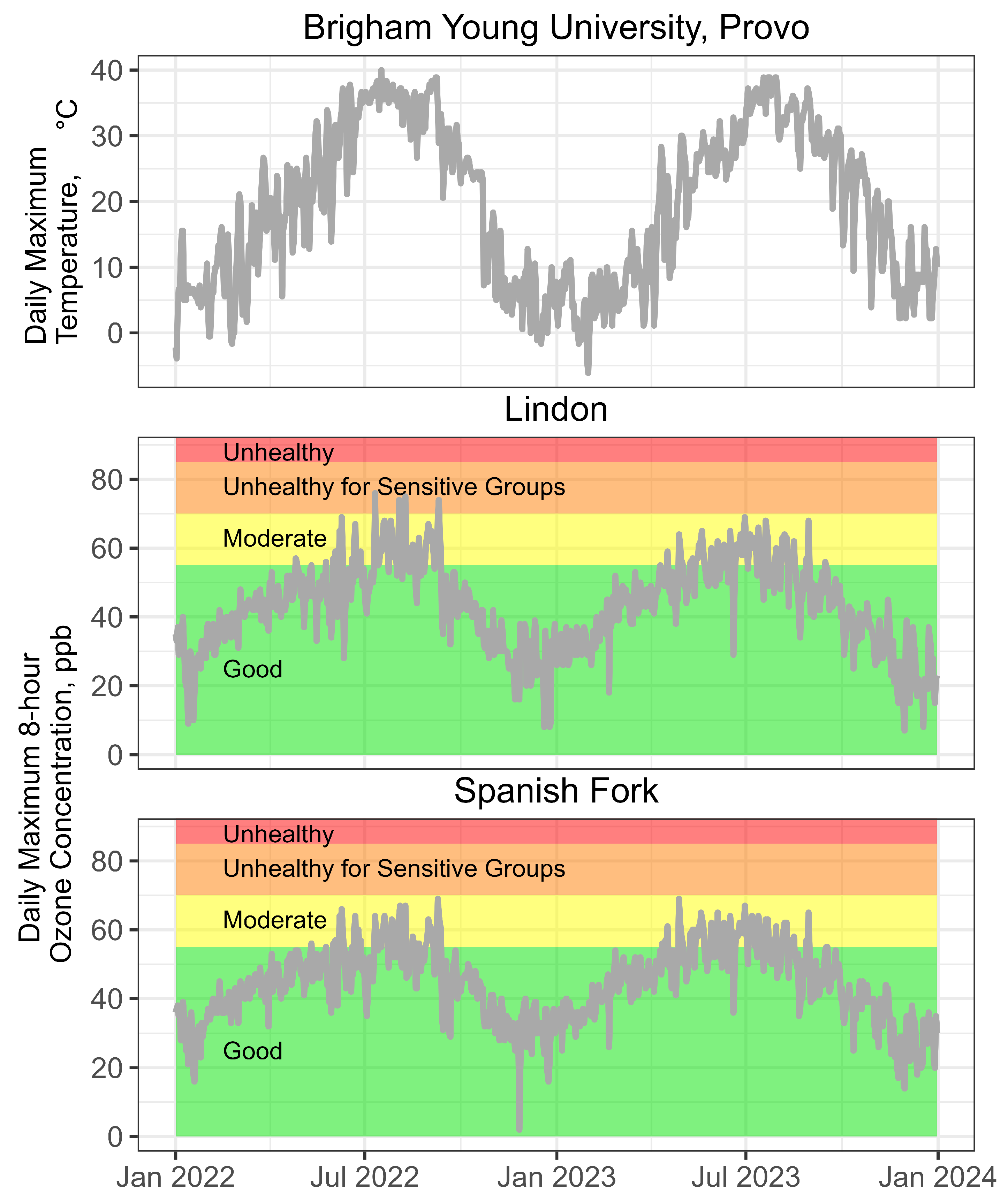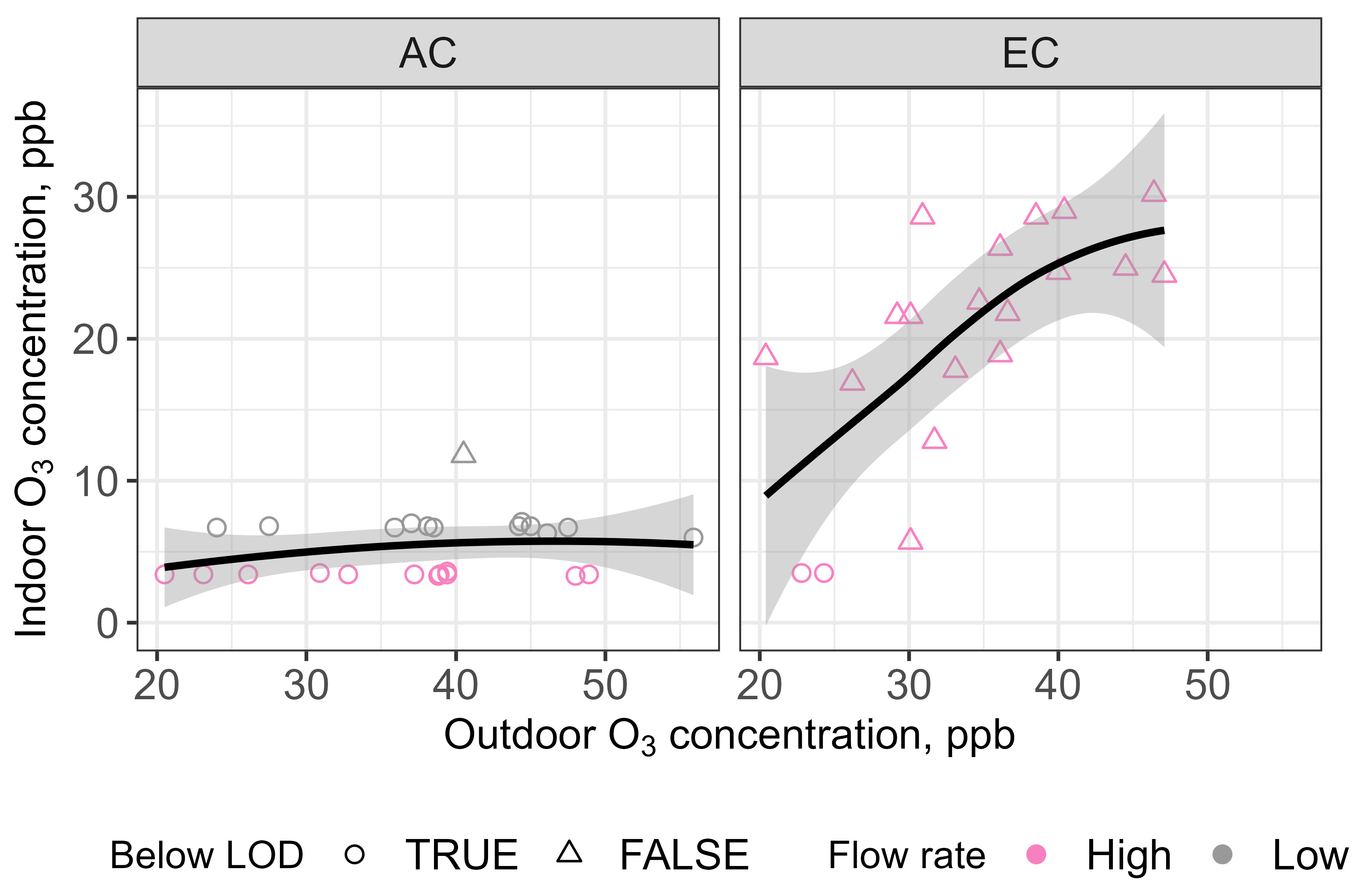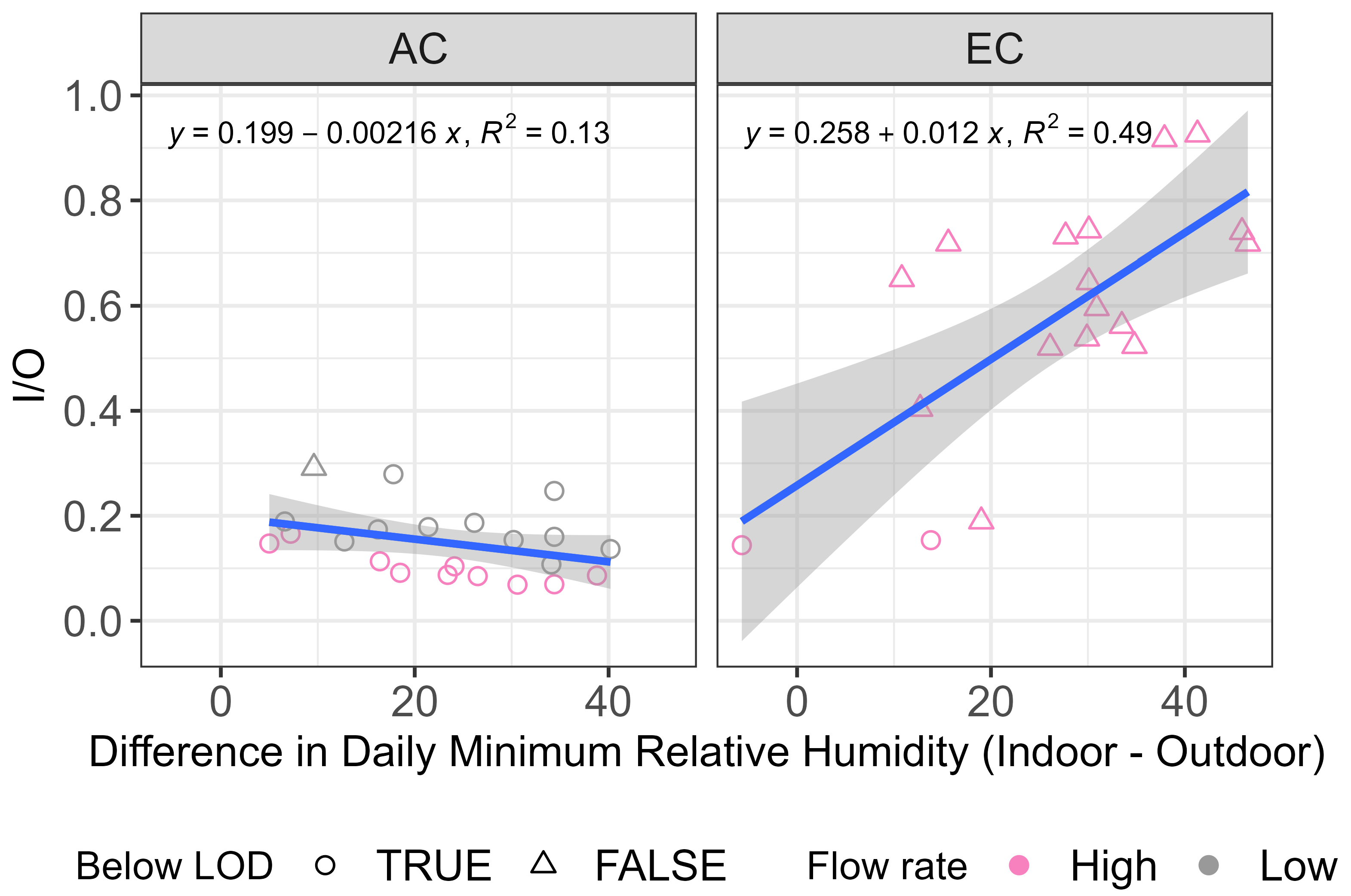Impact of Air Conditioning Type on Outdoor Ozone Intrusion into Homes in a Semi-Arid Climate
Abstract
1. Introduction
2. Materials and Methods
2.1. Study Design
2.2. Housing Questionnaire
2.3. O3 Measurement
2.4. Temperature and Relative Humidity Measurement
2.5. Quality Assurance Steps
2.6. Data Analysis Steps
- xj is the mean I/O for home, j
- I/Oi is the Indoor to Outdoor ratio of the 24 h integrated O3 concentrations for visit, i
- vj is the total number of visits made at house, j (vj = 1, 2, or 3)
- is the mean I/O for homes with air conditioning type, k (k = AC or EC)
- is the total number of homes with air conditioning type, k
- is the type 1 error rate for a confidence interval.
- For a 95% confidence interval,
- is the t-critical value based on the type I error rate and number of homes with air conditioning type, k
- sdk is the sample standard deviation from homes with air conditioning type, k
3. Results
3.1. Indoor/Outdoor Ratios
3.2. Representative I/O Ratios during Air Conditioning Use
4. Discussion
5. Conclusions
Supplementary Materials
Author Contributions
Funding
Data Availability Statement
Acknowledgments
Conflicts of Interest
References
- Seinfeld, J.H.; Pandis, S.N. Atmospheric Chemistry and Physics: From Air Pollution to Climate Change; John Wiley & Sons, Incorporated: New York, NY, USA, 2016; Available online: http://ebookcentral.proquest.com/lib/byu/detail.action?docID=4462549 (accessed on 24 June 2022).
- Zhang, J.; Wei, Y.; Fang, Z. Ozone Pollution: A Major Health Hazard Worldwide. Front. Immunol. 2019, 10, 2518. Available online: https://www.frontiersin.org/journals/immunology/articles/10.3389/fimmu.2019.02518 (accessed on 7 July 2024). [CrossRef] [PubMed]
- Nazaroff, W.W.; Weschler, C.J. Indoor ozone: Concentrations and influencing factors. Indoor Air 2021, 32, e12942. [Google Scholar] [CrossRef] [PubMed]
- Logan, J.A. Ozone in rural areas of the United States. J. Geophys. Res. Atmos. 1989, 94, 8511–8532. [Google Scholar] [CrossRef]
- Nuvolone, D.; Petri, D.; Voller, F. The effects of ozone on human health. Environ. Sci. Pollut. Res. 2017, 25, 8074–8088. [Google Scholar] [CrossRef]
- Bello-Medina, P.C.; Rodríguez-Martínez, E.; Prado-Alcalá, R.A.; Rivas-Arancibia, S. Ozone pollution, oxidative stress, synaptic plasticity, and neurodegeneration. Neurol. (Engl. Ed.) 2021, 37, 277–286. [Google Scholar] [CrossRef]
- Rivas-Arancibia, S.; Hernández-Orozco, E.; Rodríguez-Martínez, E.; Valdés-Fuentes, M.; Cornejo-Trejo, V.; Pérez-Pacheco, N.; Dorado-Martínez, C.; Zequeida-Carmona, D.; Espinosa-Caleti, I. Ozone Pollution, Oxidative Stress, Regulatory T Cells and Antioxidants. Antioxidants 2022, 11, 1553. [Google Scholar] [CrossRef]
- Wiegman, C.H.; Li, F.; Ryffel, B.; Togbe, D.; Chung, K.F. Oxidative Stress in Ozone-Induced Chronic Lung Inflammation and Emphysema: A Facet of Chronic Obstructive Pulmonary Disease. Front. Immunol. 2020, 11, 1957. [Google Scholar] [CrossRef]
- Lodovici, M.; Bigagli, E. Oxidative Stress and Air Pollution Exposure. J. Toxicol. 2011, 2011, 487074. [Google Scholar] [CrossRef]
- Hu, W.; Yang, J. Effect of ambient ozone pollution on disease burden globally: A systematic analysis for the global burden of disease study 2019. Sci. Total. Environ. 2024, 926, 171739. [Google Scholar] [CrossRef]
- EPA, U.S. NAAQS Table. Available online: https://www.epa.gov/criteria-air-pollutants/naaqs-table (accessed on 16 May 2024).
- EPA, U.S. 8-Hour Ozone Nonattainment Area Summary. 2015. Available online: https://www3.epa.gov/airquality/greenbook/jnsum.html (accessed on 28 May 2024).
- EPA, U.S. Technical Assistance Document for the Reporting of Daily Air Quality—The Air Quality Index (AQI). EPA-454/B-24-002. Available online: https://document.airnow.gov/technical-assistance-document-for-the-reporting-of-daily-air-quailty.pdf (accessed on 1 May 2024).
- Guo, C.; Gao, Z.; Shen, J. Emission rates of indoor ozone emission devices: A literature review. Build. Environ. 2019, 158, 302–318. [Google Scholar] [CrossRef]
- Zhang, Q.; Jenkins, P.L. Evaluation of ozone emissions and exposures from consumer products and home appliances. Indoor Air 2017, 27, 386–397. [Google Scholar] [CrossRef]
- Stamp, S.; Burman, E.; Chatzidiakou, L.; Cooper, E.; Wang, Y.; Mumovic, D. A critical evaluation of the dynamic nature of indoor-outdoor air quality ratios. Atmos. Environ. 2022, 273, 118955. [Google Scholar] [CrossRef]
- Rodes, C.E.; Lawless, P.A.; Thornburg, J.W.; Williams, R.W.; Croghan, C.W. DEARS particulate matter relationships for personal, indoor, outdoor, and central site settings for a general population. Atmos. Environ. 2010, 44, 1386–1399. [Google Scholar] [CrossRef]
- Janssen, N.A.H.; Hoek, G.; Brunekreef, B.; Harssema, H.; Menswik, I.; Zuidhof, A. Personal sampling of particles in Adults: Relation among Personal, Indoor, and Outdoor Air Concentrations. Am. J. Epidemiol. 1998, 147, 537–547. [Google Scholar] [CrossRef]
- Hubal, E.A.C.; Sheldon, L.S.; Burke, J.M.; McCurdy, T.R.; Berry, M.R.; Rigas, M.L.; Zartarian, V.G.; Freeman, N.C. Children’s exposure assessment: A review of factors influencing Children’s exposure, and the data available to characterize and assess that exposure. Environ. Health Perspect. 2000, 108, 475–486. [Google Scholar] [CrossRef]
- Spalt, E.W.; Curl, C.L.; Allen, R.W.; Cohen, M.; Adar, S.D.; Stukovsky, K.H.; Avol, E.; Castro-Diehl, C.; Nunn, C.; Mancera-Cuevas, K.; et al. Time–location patterns of a diverse population of older adults: The Multi-Ethnic Study of Atherosclerosis and Air Pollution (MESA Air). J. Expo. Sci. Environ. Epidemiol. 2016, 26, 349–355. [Google Scholar] [CrossRef]
- Klepeis, N.E.; Nelson, W.C.; Ott, W.R.; Robinson, J.P.; Tsang, A.M.; Switzer, P.; Behar, J.V.; Hern, S.C.; Engelmann, W.H. The National Human Activity Pattern Survey (NHAPS): A resource for assessing exposure to environmental pollutants. J. Expo. Sci. Environ. Epidemiol. 2001, 11, 231–252. [Google Scholar] [CrossRef] [PubMed]
- Weschler, C.J. Roles of the human occupant in indoor chemistry. Indoor Air 2016, 26, 6–24. [Google Scholar] [CrossRef]
- Zhang, J.; Lioy, P.J. Ozone in residential air: Concentrations, I/O ratios, indoor chemistry, and exposures. Indoor Air 1994, 4, 95–105. [Google Scholar] [CrossRef]
- Lebel, E.D.; Finnegan, C.J.; Ouyang, Z.; Jackson, R.B. Methane and NOx Emissions from Natural Gas Stoves, Cooktops, and Ovens in Residential Homes. Environ. Sci. Technol. 2022, 56, 2529–2539. [Google Scholar] [CrossRef]
- U.S. Energy Information Administration (EIA); Residential Energy Consumption Survey (RECS). Table HC7.1 Air conditioning in U.S. Homes, by Housing Unit Type, 2020. 2023. Available online: https://www.eia.gov/consumption/residential/data/2020/hc/pdf/HC%207.1.pdf (accessed on 25 June 2024).
- Yamamoto, N.; Shendell, D.G.; Winer, A.M.; Zhang, J. Residential air exchange rates in three major US metropolitan areas: Results from the Relationship Among Indoor, Outdoor, and Personal Air Study 1999–2001. Indoor Air 2010, 20, 85–90. [Google Scholar] [CrossRef] [PubMed]
- Macher, J.M.; Girman, J.R. Multiplication of microorganisms in an evaporative air cooler and possible indoor air contamination. Environ. Int. 1990, 16, 203–211. [Google Scholar] [CrossRef]
- Li, W.-W.; Paschold, H.; Morales, H.; Chianelli, J. Correlations between short-term indoor and outdoor PM concentrations at residences with evaporative coolers. Atmospheric Environ. 2003, 37, 2691–2703. [Google Scholar] [CrossRef]
- United States Geological Survey. Evaporative Coolers Work Best in the Dry Areas of the U.S. (Area A). Available online: https://www.usgs.gov/media/images/evaporative-coolers-work-best-dry-areas-us-area-a (accessed on 25 June 2024).
- Paschold, H.; Li, W.-W.; Morales, H.; Walton, J. Laboratory study of the impact of evaporative coolers on indoor PM concentrations. Atmos. Environ. 2003, 37, 1075–1086. [Google Scholar] [CrossRef]
- Sonntag, D.B.; Jung, H.; Harline, R.P.; Peterson, T.C.; Willis, S.E.; Christensen, T.R.; Johnston, J.D. Infiltration of Outdoor PM2.5 Pollution into Homes with Evaporative Coolers in Utah County. Sustainability 2023, 16, 177. [Google Scholar] [CrossRef]
- U.S. Census Bureau QuickFacts: Utah County, Utah. Available online: https://www.census.gov/quickfacts/utahcountyutah (accessed on 19 May 2024).
- USEPA, Green Book | US EPA. Available online: https://www3.epa.gov/airquality/greenbook/jbcs.html#UT (accessed on 29 May 2024).
- EPA, U.S. Ozone Designation and Classification Information. Available online: https://www.epa.gov/green-book/ozone-designation-and-classification-information (accessed on 29 May 2024).
- OSHA, Ozone in Workplace Atmospheres ID-214. Occupational Safety and Health Administration, T-ID-214-02-0801-M. Available online: https://www.osha.gov/sites/default/files/methods/osha-id214.pdf (accessed on 1 January 2008).
- BYU Physics and Astronomy Weather Station. Available online: https://marvin.byu.edu/ (accessed on 24 May 2024).
- stats version, R: Student’s t-Test. Available online: https://stat.ethz.ch/R-manual/R-devel/library/stats/html/t.test.html (accessed on 24 July 2024).
- Team, R.C. R: A Language and Environment for Statistical Computing; R Foundation for Statistical Computing: Vienna, Austria, 2023; Available online: https://www.R-project.org/ (accessed on 16 June 2023).
- R: Local Polynomial Regression Fitting. Available online: https://stat.ethz.ch/R-manual/R-devel/library/stats/html/loess.html (accessed on 27 May 2024).
- Wickham, H. ggplot2: Elegant Graphics for Data Analysis; Springer: New York, NY, USA, 2016; Available online: https://ggplot2.tidyverse.org (accessed on 1 January 2008).
- A box and whiskers plot (in the style of Tukey)—Geom_boxplot. Available online: https://ggplot2.tidyverse.org/reference/geom_boxplot.html (accessed on 2 November 2023).
- Watt, J.R.; Brown, W.K. 1937-Evaporative Air Conditioning Handbook, 3rd ed.; Distributed by Prentice Hall, PTR; Lilburn, G.A., Ed.; Fairmont Press: Upper Saddle River, NJ, USA, 1997. [Google Scholar]
- Bom, G.J. Evaporative Air-Conditioning: Applications for Environmentally Friendly Cooling; in World Bank Technical Paper; no. 421; World Bank: Washington, DC, USA, 1999. [Google Scholar]
- Yang, Y.; Cui, G.; Lan, C.Q. Developments in evaporative cooling and enhanced evaporative cooling—A review. Renew. Sustain. Energy Rev. 2019, 113, 109230. [Google Scholar] [CrossRef]
- Bolaji, B.O.; Huan, Z. Ozone depletion and global warming: Case for the use of natural refrigerant—A review. Renew. Sustain. Energy Rev. 2012, 18, 49–54. [Google Scholar] [CrossRef]
- Kapilan, N.; Isloor, A.M.; Karinka, S. A comprehensive review on evaporative cooling systems. Results Eng. 2023, 18, 101059. [Google Scholar] [CrossRef]
- Tejero-González, A.; Franco-Salas, A. Optimal operation of evaporative cooling pads: A review. Renew. Sustain. Energy Rev. 2021, 151, 111632. [Google Scholar] [CrossRef]
- Paschold, H.; Li, W.-W.; Morales, H.; Pingitore, N.E.; Maciejewska, B. Elemental analysis of airborne particulate matter and cooling water in west Texas residences. Atmos. Environ. 2003, 37, 2681–2690. [Google Scholar] [CrossRef]
- Raysoni, A.U.; Stock, T.H.; Sarnat, J.A.; Sosa, T.M.; Sarnat, S.E.; Holguin, F.; Greenwald, R.; Johnson, B.; Li, W.-W. Characterization of traffic-related air pollutant metrics at four schools in El Paso, Texas, USA: Implications for exposure assessment and siting schools in urban areas. Atmos. Environ. 2013, 80, 140–151. [Google Scholar] [CrossRef]
- Larsson, L.S. Risk-Reduction Strategies to Expand Radon Care Planning with Vulnerable Groups. Public Health Nurs. 2014, 31, 526–536. [Google Scholar] [CrossRef] [PubMed]
- Larsson, L.S.; Butterfield, P.; Hill, W.G.; Houck, G.; Messecar, D.C.; Cudney, S. Radon Testing for Low-Income Montana Families. Available online: https://aarst.org/proceedings/2011/RADON_TESTING_FOR_LOW-INCOME_MONTANA_FAMILIES.pdf (accessed on 7 July 2024).
- Hill, W.G.; Butterfield, P.; Larsson, L.S. Rural Parents’ Perceptions of Risks Associated with Their Children’s Exposure to Radon. Public Health Nurs. 2006, 23, 392–399. [Google Scholar] [CrossRef] [PubMed]
- Avery, C.L.; Mills, K.T.; Williams, R.; McGraw, K.A.; Poole, C.; Smith, R.L.; Whitsel, E.A. Estimating Error in Using Residential Outdoor PM2.5 Concentrations as Proxies for Personal Exposures: A Meta-analysis. Environ. Health Perspect. 2010, 118, 673–678. [Google Scholar] [CrossRef]
- Wheeler, A.J.; Xu, X.; Kulka, R.; You, H.; Wallace, L.; Mallach, G.; Van Ryswyk, K.; MacNeill, M.; Kearney, J.; Rasmussen, P.E.; et al. Windsor, Ontario Exposure Assessment Study: Design and Methods Validation of Personal, Indoor, and Outdoor Air Pollution Monitoring. J. Air Waste Manag. Assoc. 2011, 61, 142–156. [Google Scholar] [CrossRef]
- Department of Energy, U.S. Evaporative Coolers. Energy.gov. Available online: https://www.energy.gov/energysaver/evaporative-coolers (accessed on 28 September 2024).
- Smith, R.L.; Xu, B.; Switzer, P. Reassessing the relationship between ozone and short-term mortality in U.S. urban communities. Inhal. Toxicol. 2009, 21, 37–61. [Google Scholar] [CrossRef]
- Charles, J.W. Ozone’s Impact on Public Health: Contributions from Indoor Exposures to Ozone and Products of Ozone-Initiated Chemistry. Environ. Health Perspect. 2006, 114, 1489–1496. [Google Scholar] [CrossRef]
- Shair, F. Relating indoor pollutant concentrations of ozone and sulfur dioxide to those outside: Economic reduction of indoor ozone through selective filtration of the make-up air. ASHRAE Trans. 1981, 87, 116–139. [Google Scholar]
- Weschler, C.J.; Shields, H.C.; Naik, D.V. Ozone-removal efficiencies of activated carbon filters after more than three years of continuous service. In Proceedings of the ASHRAE Annual Meeting, Orlando, FL, USA, 25–29 June 1994; in ASHRAE Transactions, 100. ASHRAE: Orlando, FL, USA, 1994; pp. 1121–1129. [Google Scholar]
- Barkjohn, K.K.; Norris, C.; Cui, X.; Fang, L.; Zheng, T.; Schauer, J.J.; Li, Z.; Zhang, Y.; Black, M.; Zhang, J.; et al. Real-time measurements of PM2.5 and ozone to assess the effectiveness of residential indoor air filtration in Shanghai homes. Indoor Air 2020, 31, 74–87. [Google Scholar] [CrossRef]
- Bedi, N.S.; Adams, Q.H.; Hess, J.J.; Wellenius, G.A. The Role of Cooling Centers in Protecting Vulnerable Individuals from Extreme Heat. Epidemiology 2022, 33, 611–615. [Google Scholar] [CrossRef]
- Quackenboss, J.J.; Lebowitz, M.D.; Crutchfield, C.D. Indoor-outdoor relationships for particulate matter: Exposure classifications and health effects. Environ. Int. 1989, 15, 353–360. [Google Scholar] [CrossRef]
- Google LLC. Google Earth Version 10.56.0.1. Available online: https://earth.google.com/web/ (accessed on 26 June 2024).
- Utah County Evaporative Cooler Air Quality Study. Google My Maps. Available online: https://www.google.com/maps/d/u/0/edit?mid=16kZcXy2IDVdfBM13103vhYMxD5W6lY0&usp=sharing (accessed on 26 June 2024).
- Stephenson, D.J.; Lillquist, D.R. The Effects of Temperature and Pressure on Airborne Exposure Concentrations When Performing Compliance Evaluations Using ACGIH TLVs and OSHA PELs. Appl. Occup. Environ. Hyg. 2001, 16, 482–486. [Google Scholar] [CrossRef] [PubMed]
- NOAA, Station Pressure Calculator. Available online: https://www.weather.gov/epz/wxcalc_stationpressure (accessed on 6 May 2024).
- National Weather Service. Provo Municipal Airport—Time Series Viewer. Available online: https://www.weather.gov/wrh/timeseries?site=KPVU (accessed on 27 April 2024).








| Home Characteristics | AC (n = 16) | EC (n = 15) | ||||||
|---|---|---|---|---|---|---|---|---|
| Mean | SD a | Min | Max | Mean | SD a | Min | Max | |
| Age of home (yrs) | 33.0 | 26.3 | 2 | 80 | 62 | 22.6 | 21 | 100 |
| Area (m2) | 191 | 35 | 144 | 278 | 177 | 86 | 79 | 386 |
| Number of residents | 4.1 | 1.7 | 2 | 8 | 3.0 | 1.9 | 1 | 7 |
| Occupant density b | 2.1 | 0.9 | 1.0 | 3.6 | 2.0 | 1.7 | 0.5 | 7.4 |
| Owner occupied (%) | 82 | 53 | ||||||
Disclaimer/Publisher’s Note: The statements, opinions and data contained in all publications are solely those of the individual author(s) and contributor(s) and not of MDPI and/or the editor(s). MDPI and/or the editor(s) disclaim responsibility for any injury to people or property resulting from any ideas, methods, instructions or products referred to in the content. |
© 2024 by the authors. Licensee MDPI, Basel, Switzerland. This article is an open access article distributed under the terms and conditions of the Creative Commons Attribution (CC BY) license (https://creativecommons.org/licenses/by/4.0/).
Share and Cite
Johnston, J.D.; Van Roosendaal, S.; West, J.; Jung, H.; Sonntag, D. Impact of Air Conditioning Type on Outdoor Ozone Intrusion into Homes in a Semi-Arid Climate. Environments 2024, 11, 219. https://doi.org/10.3390/environments11100219
Johnston JD, Van Roosendaal S, West J, Jung H, Sonntag D. Impact of Air Conditioning Type on Outdoor Ozone Intrusion into Homes in a Semi-Arid Climate. Environments. 2024; 11(10):219. https://doi.org/10.3390/environments11100219
Chicago/Turabian StyleJohnston, James D., Seth Van Roosendaal, Joseph West, Hanyong Jung, and Darrell Sonntag. 2024. "Impact of Air Conditioning Type on Outdoor Ozone Intrusion into Homes in a Semi-Arid Climate" Environments 11, no. 10: 219. https://doi.org/10.3390/environments11100219
APA StyleJohnston, J. D., Van Roosendaal, S., West, J., Jung, H., & Sonntag, D. (2024). Impact of Air Conditioning Type on Outdoor Ozone Intrusion into Homes in a Semi-Arid Climate. Environments, 11(10), 219. https://doi.org/10.3390/environments11100219








